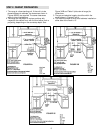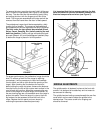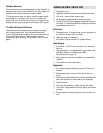
10
STEP 4: ELECTRICAL CONNECTIONS
Power Requirements
120 VAC, 60 Hz., single phase.
PRG3010 - 4 Amp. Max.
PRG3610 - 7 Amp. Max.
PRG4810 - 13 Amp. Max.
(Use 15 Amp. Circuit)
Always disconnect electric supply cord from the wall outlet
or service disconnect before servicing this appliance.
Observe all governing codes and ordinances when
grounding, in the absence of which, observe National
Electrical Code ANSI/NFPA No. 70-1990.
Recommended Grounding Method
This appliance is factory equipped with a power supply
cord with a three-prong grounding plug (with polarized
parallel blades). It must be plugged into a mating
grounding type receptacle, and connected to a correctly
polarized 120 Volt circuit. If the circuit does not have a
grounding type receptacle, it is the responsibility and
obligation of the installer or user to have the existing
receptacle changed to a properly grounded and polarized
receptacle in accordance with all applicable local codes
and ordinances by a qualified electrician. In the absence
of local codes and ordinances the receptacle replacement
shall be in accordance with the National Electrical Code.
THIS THIRD GROUND PRONG SHOULD NOT, UNDER
ANY CIRCUMSTANCES, BE CUT OR REMOVED.
(SEE FIGURE 9)
FIGURE 9
Three Prong
Receptacle
Three
Prong
Plug
Receptacle Box
Cover Plate
Ground
Prong
STEP 5: GAS REQUIREMENTS
Verify the type of gas supplied to the location.
The range is shipped from the factory set up and adjusted
for natural gas or LP gas (propane), depending on model
ordered.
Natural Gas R equirements
Connection: 1/2² N.P.T. Minimum 5/8² dia. flex line.
Pressure: 6² to 14² W.C.
LP Gas Requirements
Connection: 1/2² N.P.T., Minimum 5/8² dia. flex line.
Pressure: 11² to 14² W.C.
A regulator is required at the LP source to provide a
maximum of 14² W.C. to the range regulator.
Hook Up
A manual valve must be installed external to the
appliance, in a location accessible from the front for the
purpose of shutting off the gas supply. The supply line
must not protrude beyond the back of the unit. Make sure
the gas supply is turned off at the wall valve before
connecting the appliance.
The gas supply connections should be made by a
competent technician and in accordance with local codes
or ordinances. In the absence of a local code, the
installation must conform to the National Fuel Gas Code
ANSI 223.1-Latest Edition.
CAUTION
The appliance must be isolated from the building’s gas
supply piping system by closing its individual manual
shut-off valve during any pressure testing of the gas
supply piping system at test pressures equal to or less
than 1/2 psig (3.5kPa.).
The appliance and its individual shut-off valve must be
disconnected from the gas supply p iping system
during any pressure testing of the system at the test
pressures in excess of 1/2 psig (3.5kPa.).
When checking the manifold gas pressure, the inlet
pressure to the regulator should be at least 7.0² W. C.
for natural gas.
** The flex line for the gas supply must be metal and be
approved by an approved certifying agency (AGA, CGA,
or U.L.). Never use a hose made of rubber or other
synthetic material, as the heat may cause the hose to
melt and develop leaks.


















